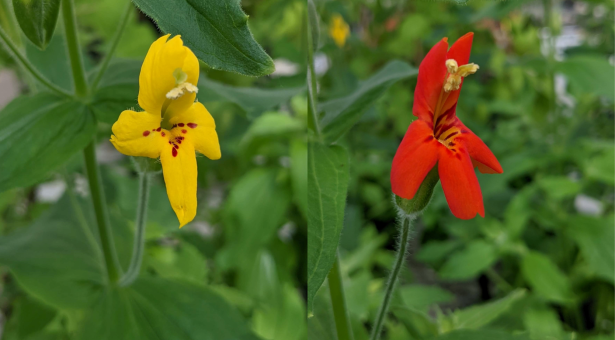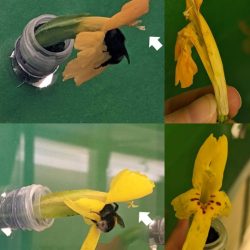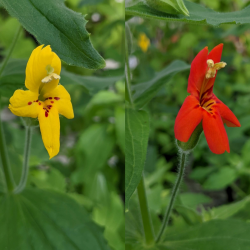
Some years ago, scientists examining wild plants in a western corner of the United States encountered a curiously colourful example of biodiversity.
Two species of red Mimulus (monkeyflowers) normally pollinated by hummingbirds (Mimulus cardinalis and Mimulus verbenaceus) have unusual, yellow-flowered populations at the edge of their ranges.
The researchers found that these rarer yellow forms seemed to be favoured by pollinating bees, but there was little information on whether other traits such as floral scent or shape were attracting them.
Decades on, Dr Kelsey Byers' research group at the John Innes Centre (JIC) has revisited this research using modern genomic and biochemical resources in controlled lab environments.
The aim was to explain the genetic and biochemical basis of the colour change and to investigate how traits such as floral colour, scent and shape might be involved in an apparent pollinator shift from hummingbird to bumblebee.
The results offer us a fascinating glimpse into the workings of biodiversity in nature and may help us engineer better pollinated, higher yielding crops.
The experiments, in controlled conditions, showed that bumblebees did indeed prefer yellow to red flowers and were twice as likely to visit them. The study also found that both types of yellow morphs had increased scent emission which could reflect selection from pollinators such as bees, which use scent to forage unlike hummingbirds.
Intriguingly, however, the shape of the flowers presented the bees with problems to the extent that they were not good pollinators for the plant itself!
Bumblebees were ill-fitted to the flowers, causing damage while attempting to access nectar and poorly contacting floral organs which would be a hindrance to efficient pollen transfer.
The study suggests that these yellow flowers represent a possible early stage in the evolutionary transition, the "adaptive walk" from hummingbird to bee pollination.
It also sheds light on the order in which floral traits may evolve in a pollinator shift, and how mutations of larger effect, in this case colour, might precede smaller changes, in scent and morphology.
A key question, which was not answerable at the time of the previous research, was whether the yellow forms in the species M. cardinalis and M. verbenaceous had evolved convergently – that is, if their characteristics were underpinned by the same genetic differences or if they had arrived by different routes. The answer from this study is both.
This study showed that some of these changes were indeed convergent, the yellow morphs resulting from an increase in the production of carotenoids (red-orange-yellow pigments) which were increased using the same genes in both species.
Other traits had emerged independently by separate means – for example red pigment regulators and floral scent compounds.
Dr Kelsey Byers, corresponding author of the study which appears in Nature Communications, said: "Even though these species are closely related, they have followed different paths to the same endpoint for many of their traits.
"We have identified ways that flowers can change and affect pollinator visitation, as well as some genetic pathways that can underlie these changes and how they have evolved in different but closely related species."
The team now plans to do some functional testing of the genes that they have found that are convergent (carotenoid pathway) or divergent (anthocyanin regulators) to see how they have evolved in this system. They are also investigating another yellow population of M.cardinalis to see whether it has followed the same convergent paths or not.
The complex partnership between plants and pollinators is essential for biodiverse ecosystems which support cleaner environments and the production of many crops.
"By understanding how traits evolve in the wild, we understand biodiversity better, and by understanding how these traits can be affected by plant genetics, we have the foundation of the ability to engineer traits to impact pollinator preference and thus crop yield," added Dr Byers.
The paper 'Within-species floral evolution reveals convergence in adaptive walks during incipient pollinator shift' appears in Nature Communications.
It was co-authored by former JIC postdoctoral researcher Dr Katie Wenzell and JIC research assistant Dr Mikhaela Neequaye. JIC informatics support was provided by senior bioinformatician Dr. Pirita Paajanen, and JIC metabolomics support by metabolite service manager Dr Lionel Hill, and analytical chemist Paul Brett.









